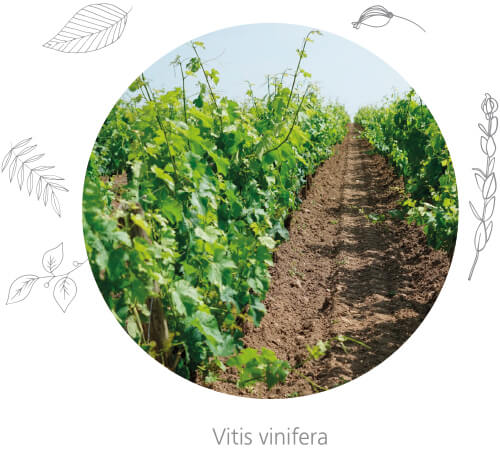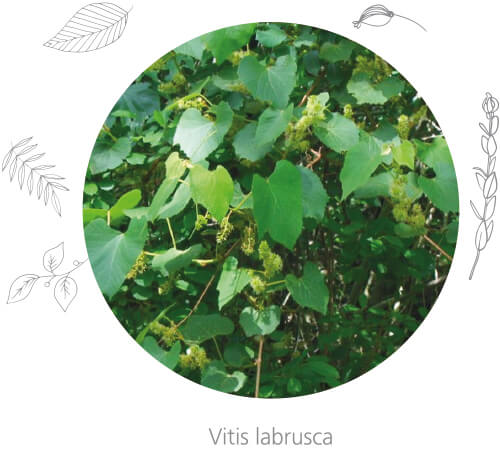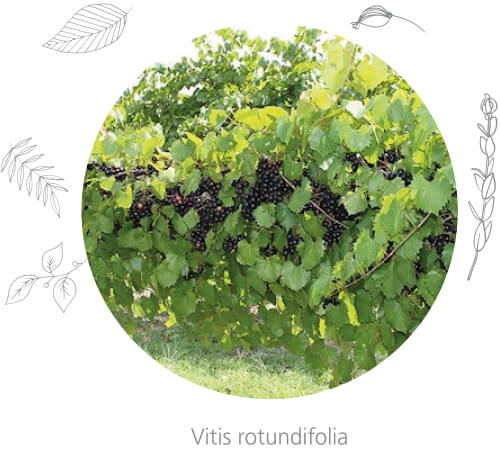-
Free Shipping in Greece over €30!

-
Shipping within 24 hours!

-
Shipping worldwide!



RESVERATROL
Grapes, known from the ancient times, except their use in wine production, contain many compounds with pharmacological properties. One of these, resveratrol, softens the fine lines and wrinkles of the skin and smoothes its texture. Also protects effectively the skin cells from deterioration, apoptosis and limiting aging.
Names - Species
Grapes except their use in wine production contain many substances with pharmacological properties. One of these is resveratrol, which is found in large quantities mainly in the skin of red grapes.
The grape is the fruit of the vine. The vine (Vitis Vinifera) is a climbing plant and its products are must, wine, vinegar and raisins. As a fruit it is known since the ancient times. According to Greek mythology, the name grape(staphyli in Greek) comes from Staphylos, who was the son of Dionysus and Ariadne.
The most common species of the genus Vitis in Europe is Vitis vinifera; Vitis labrusca and Vitis rotundifolia are grown in Northern America.

Botanical Description
The vine is a perennial plant that grows fast. Its stem has multiple branches and several arms and sprouts. The bark of the woody parts emerges into strips and separates. Sprouts in the course of time become woody branches called vine-sticks.
The leaves of the vine are large, palm-like and grow from the central stem through a smaller stem. Their shape is characteristic and it is different depending on variety and species; there are also differences in color, fluff on the lower surface and size.

History
The vine is one of the oldest cultivations. The origin of the vine is lost in the depths of the ages. Findings show that vines were cultivated in the polar regions. Cultivation slowly began to descend to the south in areas with a more mild climate, in the Caucasus region, and further south in Mesopotamia and Egypt. In Greece the cultivations of vine must have started in the 4th millennium BC. It is believed that the Greeks learned the cultivation of vine and the wine from the Eastern countries (Phoenicians and Egyptians) with whom they had trade relations.
What is important is that vine growing was spread very fast throughout Greece. This is evidenced by a multitude of coins depicting grapes on one side and the Dionysus on the other.
Ancient Greeks knew the healing properties of the vine, which they used in cases such as anemia, smallpox, constipation and liver diseases. Hippocrates recommended the grapes as a tonic.

Pharmacological Properties
Resveratrol, which is isolated usually from the skin of red grapes, is a natural polyphenol of the phytoalexin group with high antioxidant activity. It is a phyto-chemical compound with antibiotic action produced by the plant when attacked by pathogenic microorganisms such as bacteria and fungi. Also, resveratrol, like other polyphenols, protects plants from harmful oxidation. With its antioxidant action protects basic biomolecules, such as proteins, sugars, cell membrane lipids as well as cell DNA, from potential oxidative damage.
The most scientifically established action of resveratrol is that it softens fine lines and wrinkles of the skin and smoothes its texture.
Resveratrol exerts protective effect on epidermal cells by binding on specific polyphenol binding sites ([3Η]-resveratrol binding sites). Intracellular mechanisms underlying the protective effect of resveratrol are not solely due to its antioxidant activities but also involve its inhibitory action on apoptosis, a downstream mitochondrial dysfunction as revealed by the ability of resveratrol to reduce caspace-3 activity as well as the number of apoptotic cells to prevent mitochondrial dysfunctions. Considering that NO is a key mediator implicated in a broad range of age-related skin damages, resveratrol could delay and even prevent the normal cause of skin aging by blocking apoptotic events and mitochondrial dysfunctions.
Bibliograpyhy
1. Baxter RA. Anti-aging properties of resveratrol: review and report of a potent new antiox-idant skin care formulation. J Cosmet Dermatol. 2008 Mar;7(1):2-7.
2. Farris, P.A.; Krutmann, J.; Li, Y.-H.; McDaniel, D.; Krol, Y. Resveratrol: A unique antioxi-dant offering a multi-mechanistic approach for treating aging skin. J. Drugs Dermatol. 2013, 12, 1389–1394.
3. Ndiaye, M.; Philippe, C.; Mukhtar, H.; Ahmad, N. The grape antioxidant resveratrol for skin disorders: Promise, prospects and challenges. Arch. Biochem. Biophys. 2011, 508, 164–170.
4. Stéphane Bastianetto, Yvan Dumont, Albert Duranton, Freya Vercauteren, Lionel Breton, and Rémi Quirion. Protective Action of Resveratrol in Human Skin: Possible Involvement of Specific Receptor Binding Sites. PLoS One. 2010; 5(9): e12935.
5. Han YS, Bastianetto S, Dumont Y, Quirion R. Specific plasma membrane binding sites for polyphenols, including resveratrol, in the rat brain. J Pharmacol Exp Ther. 2006 Jul;318(1):238-45. Epub 2006 Mar 30.
6. Edwein Lephard. Resveratrol, 4′ Acetoxy Resveratrol, R-equol, Racemic Equol or S-equol as Cosmeceuticals to Improve Dermal Health. DOI: 10.3390/ijms18061193
7. Aziz MH, Afaq F, Ahmad N. Prevention of ultraviolet-B radiation damage by resveratrol in mouse skin is mediated via modulation in survivin. Photochem Photobiol. 2005 Jan-Feb; 81(1):25-31.
8. Afaq F, Mukhtar H. Botanical antioxidants in the prevention of photocarcinogenesis and photoaging. Exp Dermatol. 2006 Sept; 15(9):678–84.
9. Adhami VM, Afaq F, Ahmad N. Suppression of ultraviolet B exposure-mediated activation of NF-kappaB in normal human keratinocytes by resveratrol. Neoplasia. 2003 Jan-Feb;5(1):74-82.
10. Chen ML, Li J, Xiao WR, et al. Protective effect of resveratrol against oxidative damage of UVA irradiated HaCaT cells. Journal of Central South University Medical Sciences. 2006 Oct; 31(5):635–9.
11. Fernández AF, Fraga MF (Jul 2011). "The effects of the dietary polyphenol resveratrol on human healthy aging and lifespan." Epigenetics: official journal of the DNA Methylation Society 6 (7): 870–4.
12. Robb EL, Page MM, Wiens BE, Stuart JA (March 2008). "Molecular mechanisms of oxida-tive stress resistance induced by resveratrol: Specific and progressive induction of MnSOD". Biochem. Biophys. Res. Commun. 367 (2): 406–12.
13. Stefani M, Markus MA, Lin RC, Pinese M, Dawes IW, Morris BJ (October 2007). "The ef-fect of resveratrol on a cell model of human aging". Annals of the New York Academy of Sciences 1114: 407–18.
14. Park SJ, Ahmad F, Philp A, Baar K, Williams T, Luo H, Ke H, Rehmann H, Taussig R, Brown AL, Kim MK, Beaven MA, Burgin AB, Manganiello V, Chung JH (February 2012). "Resveratrol ameliorates aging-related metabolic phenotypes by inhibiting cAMP phos-phodiesterases". Cell 148 (3): 421–33.
15. Baur JA, Pearson KJ, Price NL, Jamieson HA, Lerin C, Kalra A, Prabhu VV, Allard JS, Lopez-Lluch G, Lewis K, Pistell PJ, Poosala S, Becker KG, Boss O, Gwinn D, Wang M, Ramaswamy S, Fishbein KW, Spencer RG, Lakatta EG, Le Couteur D, Shaw RJ, Navas P, Puigserver P, Ingram DK, de Cabo R, Sinclair DA (November 2006). "Resveratrol im-proves health and survival of mice on a high-calorie diet". Nature 444 (7117): 337–42.
16. Baur JA, Sinclair DA. Therapeutic potential of resveratrol: the in vivo evidence. Nature Rev Drug Disc 2006 Jun;5(6):493-506.
17. Polonini, H.C.; Lima, L.L.; Goncalves, K.M.; do Carmo, A.M.R.; da Silva, A.D.; Raposo, N.R.B. Photoprotective activity of resveratrol analogues. Bioorang. Med. Chem. 2013, 21, 964–968.
18. Fulda S, Debatin KM. Resveratrol modulation of signal transduction in apoptosis and cell survival: a mini-review. Cancer Detect Prev 2006; 30: 217–23
19. Reagan-Shaw S, Mukhtar H, Ahmad N. Resveratrol imparts photoprotection of normal cells and enhances the efficacy of radiation therapy in cancer cells. Photochem Photobiol. 2008;84:415–421.
20. Aziz MH, Kumar R, Ahmad N. Cancer chemoprevention by resveratrol: in vitro and in vivo studies and the underlying mechanisms (review) Int J Oncol. 2003;23:17–28.
21. Aziz MH, Nihal M, Fu VX, Jarrard DF, Ahmad N. Resveratrol-caused apoptosis of human prostate carcinoma LNCaP cells is mediated via modulation of phosphatidylinositol 3'-kinase/Akt pathway and Bcl-2 family proteins. Mol Cancer Ther. 2006;5:1335–1341.
22. Reagan-Shaw S, Afaq F, Aziz MH, Ahmad N. Modulations of critical cell cycle regulatory events during chemoprevention of ultraviolet B-mediated responses by resveratrol in SKH-1 hairless mouse skin. Oncogene. 2004;23:5151–5160.
23. Shankar S, Singh G, Srivastava RK. Chemoprevention by resveratrol: molecular mecha-nisms and therapeutic potential. Front Biosci. 2007;12:4839–4854.
24. Jang M, Pezzuto JM. Cancer chemopreventive activity of resveratrol. Drugs Exp Clin Res. 1999;25:65–77.
25. Park JW, Choi YJ, Jang MA, Lee YS, Jun DY, Suh SI, Baek WK, Suh MH, Jin IN, Kwon TK. Chemopreventive agent resveratrol, a natural product derived from grapes, reversibly in-hibits progression through S and G2 phases of the cell cycle in U937 cells. Cancer Lett. 2001;163:43–49.
26. Jang M, Cai L, Udeani GO, Slowing KV, Thomas CF, Beecher CW, Fong HH, Farnsworth NR, Kinghorn AD, Mehta RG, Moon RC, Pezzuto JM. Cancer chemopreventive activity of resveratrol, a natural product derived from grapes. Science. 1997;275:218–220.
27. Adhami VM, Afaq F, Ahmad N. Involvement of the retinoblastoma (pRb)-E2F/DP path-way during antiproliferative effects of resveratrol in human epidermoid carcinoma (A431) cells. Biochem Biophys Res Commun. 2001;288:579–585.
28. Ahmad N, Adhami VM, Afaq F, Feyes DK, Mukhtar H. Resveratrol causes WAF-1/p21-mediated G(1)-phase arrest of cell cycle and induction of apoptosis in human epidermoid carcinoma A431 cells. Clin Cancer Res. 2001;7:1466–1473.
29. Yang Z, Yang S, Misner BJ, Chiu R, Liu F, Meyskens FL., Jr Nitric oxide initiates progres-sion of human melanoma via a feedback loop mediated by apurinic/apyrimidinic endonu-clease-1/redox factor-1. which is inhibited by resveratrol, Mol Cancer Ther. 2008;7:3751–3760.
30. Cross CE, van der Vliet A, Louie S, Thiele JJ, Halliwell B. Oxidative stress and antioxidants at biosurfaces: plants, skin, and respiratory tract surfaces. Environ Health Perspect. 1998;106 Suppl 5:1241–1251.
31. Frankel EN, Waterhouse AL, Kinsella JE. Inhibition of human LDL oxidation by resvera-trol. Lancet. 1993;341:1103–1104.
32. Kimura Y, Okuda H, Arichi S. Effects of stilbenes on arachidonate metabolism in leuko-cytes. Biochim Biophys Acta. 1985;834:275–278.
33. Bertelli AA, Giovannini L, Giannessi D, Migliori M, Bernini W, Fregoni M, Bertelli A. An-tiplatelet activity of synthetic and natural resveratrol in red wine. Int J Tissue React. 1995;17:1–3.
34. Hadi SM, Ullah MF, Azmi AS, Ahmad A, Shamim U, Zubair H, Khan HY. Resveratrol mobi-lizes endogenous copper in human peripheral lymphocytes leading to oxidative DNA breakage: a putative mechanism for chemoprevention of cancer. Pharm Res. 2010;27:979–988.
35. Chow HH, Garland LL, Hsu CH, Vining DR, Chew WM, Miller JA, Perloff M, Crowell JA, Alberts DS. Resveratrol modulates drug- and carcinogen-metabolizing enzymes in a healthy volunteer study. Cancer Prev Res (Phila) 2010;3:1168–1175.
36. Afaq F, Adhami VM, Ahmad N. Prevention of short-term ultraviolet B radiation-mediated damages by resveratrol in SKH-1 hairless mice. Toxicol Appl Pharmacol. 2003;186:28–37.
37. Chun YJ, Kim MY, Guengerich FP. Resveratrol is a selective human cytochrome P450 1A1 inhibitor. Biochem Biophys Res Commun. 1999;262:20–24.
38. Ciolino HP, Daschner PJ, Yeh GC. Resveratrol inhibits transcription of CYP1A1 in vitro by preventing activation of the aryl hydrocarbon receptor. Cancer Res. 1998;58:5707–5712.
39. Pezzuto JM. Resveratrol as an Inhibitor of Carcinogenesis. Pharm Biol. 2008;46:443–573.
40. Packer L, Valacchi G. Antioxidants and the response of skin to oxidative stress: vitamin E as a key indicator. Skin Pharmacol Appl Skin Physiol. 2002;15:282–290.
41. Niles RM, McFarland M, Weimer MB, Redkar A, Fu YM, Meadows GG. Resveratrol is a po-tent inducer of apoptosis in human melanoma cells. Cancer Lett. 2003;190:157–163.
42. Yang S, Meyskens FL., Jr Alterations in activating protein 1 composition correlate with phenotypic differentiation changes induced by resveratrol in human melanoma. Mol Pharmacol. 2005;67:298–308.
43. Osmond GW, Augustine CK, Zipfel PA, Padussis J, Tyler DS. Enhancing Melanoma Treat-ment with Resveratrol. J Surg Res. 2010 Epub ahead of print.
44. Liu Y, Chan F, Sun H, Yan J, Fan D, Zhao D, An J, Zhou D. Resveratrol protects human keratinocytes HaCaT cells from UVA-induced oxidative stress damage by downregulating Keap1 expression. Eur J Pharmacol. 2010 Epub ahead of print.
45. Aziz MH, Reagan-Shaw S, Wu J, Longley BJ, Ahmad N. Chemoprevention of skin cancer by grape constituent resveratrol: relevance to human disease? FASEB J. 2005;19:1193–1195.
46. Kim KH, Back JH, Zhu Y, Arbesman J, Athar M, Kopelovich L, Kim AL, Bickers DR. Resveratrol Targets Transforming Growth Factor-beta2 Signaling to Block UV-Induced Tumor Progression. J Invest Dermatol. ]
47. Kundu JK, Chun KS, Kim SO, Surh YJ. Resveratrol inhibits phorbol ester-induced cycloox-ygenase-2 expression in mouse skin: MAPKs and AP-1 as potential molecular targets. Bio-factors. 2004;21:33–39.
48. van Ginkel PR, Darjatmoko SR, Sareen D, Subramanian L, Bhattacharya S, Lindstrom MJ, Albert DM, Polans AS. Resveratrol inhibits uveal melanoma tumor growth via early mito-chondrial dysfunction. Invest Ophthalmol Vis Sci. 2008;49:1299–1306.
49. Yang S, Irani K, Heffron SE, Jurnak F, Meyskens FL., Jr Alterations in the expression of the apurinic/apyrimidinic endonuclease-1/redox factor-1 (APE/Ref-1) in human melanoma and identification of the therapeutic potential of resveratrol as an APE/Ref-1 inhibitor. Mol Cancer Ther. 2005;4:1923–1935.
50. Wong Y, Osmond G, Brewer KI, Tyler DS, Andrus MB. Synthesis of 4'-ester analogs of resveratrol and their evaluation in malignant melanoma and pancreatic cell lines. Bioorg Med Chem Lett. 2010;20:1198–1201.
51. Moran BW, Anderson FP, Devery A, Cloonan S, Butler WE, Varughese S, Draper SM, Kenny PT. Synthesis, structural characterisation and biological evaluation of fluorinated analogues of resveratrol. Bioorg Med Chem. 2009;17:4510–4522.
52. Cottart CH, Nivet-Antoine V, Laguillier-Morizot C, Beaudeux JL. Resveratrol bioavailability and toxicity in humans. Mol Nutr Food Res. 2010;54:7–16.
53. Nunes T, Almeida L, Rocha JF, Falcao A, Fernandes-Lopes C, Loureiro AI, Wright L, Vaz-da-Silva M, Soares-da-Silva P. Pharmacokinetics of trans-resveratrol following repeated administration in healthy elderly and young subjects. J Clin Pharmacol. 2009;49:1477–1482. [PubMed]
54. Burkon A, Somoza V. Quantification of free and protein-bound trans-resveratrol metabo-lites and identification of trans-resveratrol-C/O-conjugated diglucuronides - two novel resveratrol metabolites in human plasma. Mol Nutr Food Res. 2008;52:549–557.
55. de Santi C, Pietrabissa A, Mosca F, Pacifici GM. Glucuronidation of resveratrol, a natural product present in grape and wine, in the human liver. Xenobiotica. 2000;30:1047–1054.
56. De Santi C, Pietrabissa A, Spisni R, Mosca F, Pacifici GM. Sulphation of resveratrol, a nat-ural compound present in wine, and its inhibition by natural flavonoids. Xenobiotica. 2000;30:857–866. [PubMed]
57. De Santi C, Pietrabissa A, Spisni R, Mosca F, Pacifici GM. Sulphation of resveratrol, a nat-ural product present in grapes and wine, in the human liver and duodenum. Xenobiotica. 2000;30:609–617. [PubMed]
58. Niles RM, Cook CP, Meadows GG, Fu YM, McLaughlin JL, Rankin GO. Resveratrol is rapid-ly metabolized in athymic (nu/nu) mice and does not inhibit human melanoma xenograft tumor growth. J Nutr. 2006;136:2542–2546. [PMC free article] [PubMed]
59. Gao X, Xu YX, Divine G, Janakiraman N, Chapman RA, Gautam SC. Disparate in vitro and in vivo antileukemic effects of resveratrol, a natural polyphenolic compound found in grapes. J Nutr. 2002;132:2076–2081. [PubMed]
60. Hecht SS, Kenney PM, Wang M, Trushin N, Agarwal S, Rao AV, Upadhyaya P. Evaluation of butylated hydroxyanisole, myo-inositol, curcumin, esculetin, resveratrol and lycopene as inhibitors of benzo[a]pyrene plus 4-(methylnitrosamino)-1-(3-pyridyl)-1-butanone-induced lung tumorigenesis in A/J mice. Cancer Lett. 1999;137:123–130. [PubMed]
61. Ziegler CC, Rainwater L, Whelan J, McEntee MF. Dietary resveratrol does not affect intes-tinal tumorigenesis in Apc(Min/+) mice. J Nutr. 2004;134:5–10. [PubMed]
62. Brown VA, Patel KR, Viskaduraki M, Crowell JA, Perloff M, Booth TD, Vasilinin G, Sen A, Schinas AM, Piccirilli G, Brown K, Steward WP, Gescher AJ, DE B. Repeat Dose Study of the Cancer Chemopreventive Agent Resveratrol in Healthy Volunteers: Safety, Pharmaco-kinetics, and Effect on the Insulin-like Growth Factor Axis. Cancer Res. 2010 [PMC free ar-ticle] [PubMed]
63. la Porte C, Voduc N, Zhang G, Seguin I, Tardiff D, Singhal N, Cameron DW. Steady-State pharmacokinetics and tolerability of trans-resveratrol 2000 mg twice daily with food, quercetin and alcohol (ethanol) in healthy human subjects. Clin Pharmacokinet. 2010;49:449–454. [PubMed]
64. Hung CF, Lin YK, Huang ZR, Fang JY. Delivery of resveratrol, a red wine polyphenol, from solutions and hydrogels via the skin. Biol Pharm Bull. 2008;31:955–962.
65. Kobierski S, Ofori-Kwakye K, Muller RH, Keck CM. Resveratrol nanosuspensions for der-mal application--production, characterization, and physical stability. Pharmazie. 2009;64:741–747.
66. Ndiaye M, Kumar R, Ahmad N. Resveratrol in Cancer Management: Where are we and where we go from here? Ann NY Acad Sci. 2010 In Press.
67. Boocock DJ, Faust GE, Patel KR, Schinas AM, Brown VA, Ducharme MP, Booth TD, Crowell JA, Perloff M, Gescher AJ, Steward WP, Brenner DE. Phase I dose escalation pharmacokinetic study in healthy volunteers of resveratrol, a potential cancer chemopre-ventive agent. Cancer Epidemiol Biomarkers Prev. 2007;16:1246–1252.
68. Vaz-da-Silva M, Loureiro AI, Falcao A, Nunes T, Rocha JF, Fernandes-Lopes C, Soares E, Wright L, Almeida L, Soares-da-Silva P. Effect of food on the pharmacokinetic profile of trans-resveratrol. Int J Clin Pharmacol Ther. 2008;46:564–570.
69. Almeida L, Vaz-da-Silva M, Falcao A, Soares E, Costa R, Loureiro AI, Fernandes-Lopes C, Rocha JF, Nunes T, Wright L, Soares-da-Silva P. Pharmacokinetic and safety profile of trans-resveratrol in a rising multiple-dose study in healthy volunteers. Mol Nutr Food Res. 2009;53 Suppl 1:S7–S15.
70. Vitaglione P, Sforza S, Galaverna G, Ghidini C, Caporaso N, Vescovi PP, Fogliano V, Marchelli R. Bioavailability of trans-resveratrol from red wine in humans. Mol Nutr Food Res. 2005;49:495–504.
71. Goldberg DM, Yan J, Soleas GJ. Absorption of three wine-related polyphenols in three different matrices by healthy subjects. Clin Biochem. 2003;36:79–87.
72. Roy P, Madan E, Kalra N, Nigam N, George J, Ray RS, Hans RK, Prasad S, Shukla Y. Resveratrol enhances ultraviolet B-induced cell death through nuclear factor-kappaB pathway in human epidermoid carcinoma A431 cells. Biochem Biophys Res Commun. 2009;384:215–220.
73. Madan E, Prasad S, Roy P, George J, Shukla Y. Regulation of apoptosis by resveratrol through JAK/STAT and mitochondria mediated pathway in human epidermoid carcinoma A431 cells. Biochem Biophys Res Commun. 2008;377:1232–1237.
74. Kim AL, Zhu Y, Zhu H, Han L, Kopelovich L, Bickers DR, Athar M. Resveratrol inhibits proliferation of human epidermoid carcinoma A431 cells by modulating MEK1 and AP-1 signalling pathways. Exp Dermatol. 2006;15:538–546.
75. Kowalczyk MC, Walaszek Z, Kowalczyk P, Kinjo T, Hanausek M, Slaga TJ. Differential ef-fects of several phytochemicals and their derivatives on murine keratinocytes in vitro and in vivo: implications for skin cancer prevention. Carcinogenesis. 2009;30:1008–1015.
76. Park K, Lee JH. Protective effects of resveratrol on UVB-irradiated HaCaT cells through attenuation of the caspase pathway. Oncol Rep. 2008;19:413-417.
77. Fabbrocini G, Kisslinger A, Iannelli P, Vitale N, Procaccini C, Sparaneo G, Chieffi P, Ayala F, Mancini FP, Tramontano D. Resveratrol regulates p66Shc activation in HaCaT cells. Exp Dermatol. 2010;19:895–903.
78. Kim KH, Back JH, Zhu Y, Arbesman J, Athar M, Kopelovich L, Kim AL, Bickers DR. Resveratrol Targets Transforming Growth Factor-beta2 Signaling to Block UV-Induced Tumor Progression. J Invest Dermatol. 2010 Epub ahead of print.
79. Soleas GJ, Grass L, Josephy PD, Goldberg DM, Diamandis EP. A comparison of the anti-carcinogenic properties of four red wine polyphenols. Clin Biochem. 2002;35:119-124.
80. Asensi M, Medina I, Ortega A, Carretero J, Bano MC, Obrador E, Estrela JM. Inhibition of cancer growth by resveratrol is related to its low bioavailability. Free Radic Biol Med. 2002;33:387–398.
81. Kowalczyk MC, Kowalczyk P, Tolstykh O, Hanausek M, Walaszek Z, Slaga TJ. Synergistic effects of combined phytochemicals and skin cancer prevention in SENCAR mice. Cancer Prev Res (Phila) 2010;3:170–178.
82. Gatouillat G, Balasse E, Joseph-Pietras D, Morjani H, Madoulet C. Resveratrol induces cell-cycle disruption and apoptosis in chemoresistant B16 melanoma. J Cell Biochem. 2010;110:893–902.
83. Roy P, Kalra N, Prasad S, George J, Shukla Y. Chemopreventive potential of resveratrol in mouse skin tumors through regulation of mitochondrial and PI3K/AKT signaling path-ways. Pharm Res. 2009;26:211–217.
84. Kalra N, Roy P, Prasad S, Shukla Y. Resveratrol induces apoptosis involving mitochondrial pathways in mouse skin tumorigenesis. Life Sci. 2008;82:348–358.
85. Yusuf N, Nasti TH, Meleth S, Elmets CA. Resveratrol enhances cell-mediated immune re-sponse to DMBA through TLR4 and prevents DMBA induced cutaneous carcinogenesis. Mol Carcinog. 2009;48:713–723.
86. Boily G, He XH, Pearce B, Jardine K, McBurney MW. SirT1-null mice develop tumors at normal rates but are poorly protected by resveratrol. Oncogene. 2009;28:2882-2893.
87. Nichols JA, Katiyar SK. Skin photoprotection by natural polyphenols: anti-inflammatory, antioxidant and DNA repair mechanisms. Arch Dermatol Res. 2010;302:71-83.












